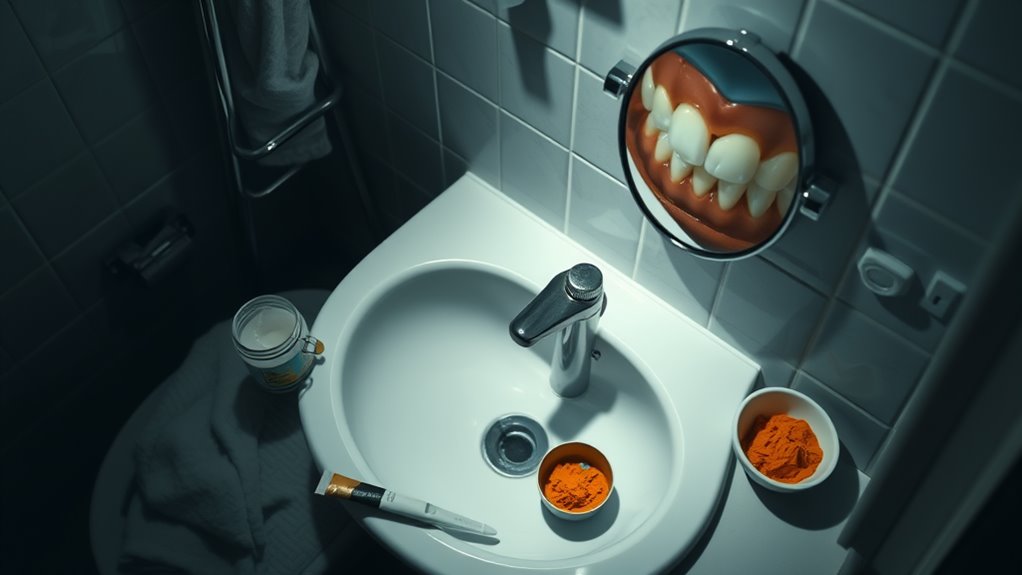Ice Cream Hurts Your Teeth. You Might Have THIS Hidden Problem!
If your teeth hurt when eating ice cream, you might have dentinal hypersensitivity – a condition where worn enamel exposes tiny tubes in your teeth’s dentin layer. This makes your teeth extra sensitive to temperature changes, especially cold foods. While sensitivity is common, it can also signal deeper issues like cracked teeth or receding gums. The good news? Several effective treatments exist, and understanding the root cause is your first step to relief.
Why Ice Cream Makes Your Teeth Hurt
When you bite into ice cream, the sudden temperature change can trigger sensitivity in your teeth, causing a sharp, shooting pain. This reaction occurs because the cold temperature makes the tiny tubules in your tooth’s dentin contract quickly.
These tubules contain fluid that moves when exposed to temperature changes, stimulating the nerves inside your teeth.
If you’ve got sensitive teeth, you’ll feel this sensation more intensely. Your teeth might be sensitive due to worn enamel, receding gums, or microscopic cracks in your teeth.
These conditions expose more of your dentin to temperature changes. The pain you’re experiencing isn’t just uncomfortable – it’s your teeth telling you something’s wrong.
Regular dental check-ups can help identify and address the underlying causes of tooth sensitivity.
Understanding Tooth Sensitivity and Cold Foods
Although many people enjoy cold treats, understanding why they trigger tooth sensitivity can help you manage discomfort better. When your teeth come into contact with cold foods like ice cream, the rapid temperature change causes the tooth material to contract quickly. This sudden change can stimulate the nerve endings inside your teeth, especially if you have worn enamel or exposed dentin.
Your teeth might be particularly sensitive to cold foods if you have:
- Receding gums that expose the sensitive root areas
- Weakened enamel from acidic foods or aggressive brushing
- Microscopic cracks in your teeth from grinding or clenching
The severity of your sensitivity can vary based on your oral health condition and how well you protect your teeth from these common triggers.
Signs of Hidden Dental Problems
If you experience tooth sensitivity while eating ice cream, it might signal underlying dental issues that require attention. Watch for these warning signs: persistent pain that lingers after consuming cold foods, visible cracks in your teeth, receding gums, or worn-down enamel.
You’ll want to pay special attention if you notice pain when biting down, swollen gums, or dark spots on your teeth. These symptoms could indicate cavities, fractured teeth, exposed roots, or gum disease.
Sometimes, teeth grinding at night can cause sensitivity by wearing down your protective enamel. Don’t ignore persistent sensitivity – it rarely resolves on its own and may worsen over time.
Early detection and treatment by your dentist can prevent more serious complications and help preserve your dental health.
The Role of Tooth Enamel in Sensitivity
Tooth enamel, your teeth’s protective shield, plays a vital role in preventing sensitivity to cold foods like ice cream. When this hard outer layer becomes damaged or worn down, the sensitive dentin underneath becomes exposed, leading to that sharp, painful sensation when you eat frozen treats.
Your enamel can weaken due to several factors that directly impact your teeth’s sensitivity to cold:
- Aggressive brushing that wears down the enamel over time
- Acidic foods and drinks that gradually erode the protective layer
- Grinding your teeth, which can crack or chip the enamel
Once your enamel is compromised, the microscopic tubes in your dentin send pain signals to the nerve endings when they come in contact with cold temperatures.
Unfortunately, your body can’t regenerate enamel, so protecting what you have is crucial.
Treatment Options for Sensitive Teeth
While dealing with sensitive teeth can be frustrating, several effective treatment options can help you enjoy ice cream and other cold treats again.
You can start by switching to a desensitizing toothpaste that contains compounds like potassium nitrate or strontium acetate. These ingredients work by blocking the transmission of pain signals from your tooth surface to the nerve endings.
Your dentist might recommend in-office treatments like fluoride varnishes or dental sealants that strengthen your enamel and protect exposed dentin.
For severe cases, they could suggest bonding agents or gum grafts to cover exposed root surfaces.
You’ll also want to avoid acidic foods and drinks that can worsen sensitivity, and always use a soft-bristled toothbrush with gentle brushing motions to prevent further enamel wear.
Prevention Tips for Long-Term Relief
Maintaining good oral hygiene habits is essential for preventing tooth sensitivity in the long run. You’ll need to be mindful of your daily dental care routine and avoid habits that can worsen sensitivity.
Using a soft-bristled toothbrush and gentle brushing techniques will help protect your tooth enamel from wear.
To minimize tooth sensitivity, consider these protective measures:
- Limit acidic foods and beverages that can erode enamel
- Wait 30 minutes after eating before brushing to protect softened enamel
- Use a desensitizing toothpaste as part of your daily routine
If you grind your teeth at night, ask your dentist about getting a custom mouthguard.
Regular dental check-ups will help identify potential issues before they lead to increased sensitivity.
Remember to replace your toothbrush every three months for optimal cleaning effectiveness.




